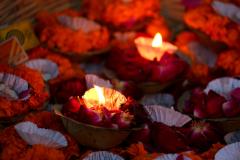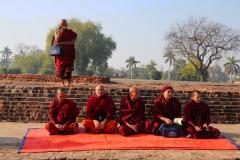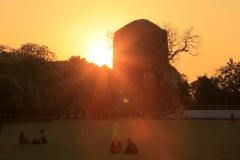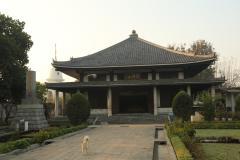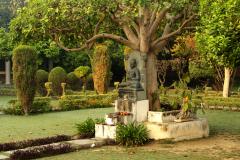Welcome to land of Buddha
Last few words on Varanasi and Hinduism, Buddha's CV and the Noble Eightfold Path
After 12 days I left Varanasi, or more precisely, I was forced to leave, because the manager of the guesthouse where I stayed said, that in whole Varanasi there is a rule that a foreigner cannot stay in the same guesthouse for more than 10 days – he told me this on my 7th day, and at the end I stayed there for 11 days. Anyway, at least something forced me to leave. Not that I would be really interested in staying longer, but I felt still weak. After the antibiotics killed the plague from Kumbh Mela and my digestion got operational again, my body decided to continue its protest against India and I got fever and cough and sore throat again and overall felt pretty weak. Yes, my immunity is broken into pieces, I see that. I guess that staying in the city where people from all over India come to die, is not the best way how to cleanse your body, so despite feeling weak I was glad to leave to nearby Sarnath, which is one of the 4 most important Buddhist sites, as in Sarnath Buddha for the first time preached his Noble Eightfold Path, or the Middle Way, to his first 5 followers, after attaining enlightenment in Bodhgaya (my next destination).
As I mentioned in my last log, Varanasi was the last major Indian Hindu spot on my journey. In retrospective, it’s very clear what, or “who”, to be more precise, I have been in the last almost 3 months: a pilgrim. I did not intended it this way, remember that I hadn’t had any upfront plan (except for going to the ashram), but it’s only logical, that it worked out this way. I came to India for some spiritual enrichment and restart, and thus becoming a pilgrim was the most probable outcome, when I think about it now. And why do I say I have been a pilgrim? Well, India is huge. HUGE. I might have travelled across Rajastan (northwestern India, near Pakistani border) to see the most majestic Indian palaces and monuments. I might have travelled across India’s many national parks and mountains to see elephants and tigers. I might have travelled across Indian metropolitan cities like Mumbay, Delhi, Calcutta, Chennai – but I avoided them all. I could have focused on innumerable historic monuments, but I have seen only few. Back tracing my steps, I see that I started in the ashram in holy city of Rishikesh, took vacation with my friends in Sri Lanka, and then went from one pilgrimage destination to another – Madurai, Rameshwaram, Kanyakumari, short Christian break in Kerala, Allahabad and finally Varanasi. But there’s more about this pilgrimage than visiting the holy cities. Just like a good pilgrim should, I have completely avoided alcohol while in India (I had 3 beers in the last 3 months, and one of those was given to me, and one rum & coke; yes in Sri Lanka I had some booze – 3 beers and few shots of rum, which is still extremely limited for my standards), I have lived in complete celibacy (and I have hardly even spoken to any woman), in 3 months I have spoken less words than during 1 day in Slovakia, and I have spent most of the time by thinking, chanting and meditating. My only sin is smoking beedees, which is perfectly allowed for Hindu pilgrim, but anyway I smoked very little in the last 3 weeks. Yes, I definitely match the criteria for a pilgrim.
As I randomly wrote here many references to Hinduism, here at the end of my Hindu circuit, and at the beginning of my Buddhist circuit, I decided to sum up for you some very basics of Hinduism, so that you can make some sense of it, finally. If you want to, of course. And also for me, to remember it one day :-)
I posted it in Mixed Grill section. It’s pretty long for “basics”.
And last note on Varanasi. When I was here 4 years ago, I was fascinated by the city: its colors, its tiny cow-filled alleys, its spirituality, the weird atmosphere of the public cremations… I thought that I would keep coming back, many times, to feed on its magic. But after this visit, no, I don’t think I ever need to come here again. If I happen to be traveling across India again, I will not mind stopping here, but I do not feel any strong urge to return here. I think that the city gave me what it could have given to me, that I soaked its mystique. Besides that, after Maha Kumbh Mela and these 2 weeks of Varanasi, I have seen more people, smelt more urine and waded through more shit (human in Kumbh Mela, cows in Varanasi) than what is enough for any man in his whole lifetime. No, I was not born for these hectic crowds. I need to rejuvenate my spirit in the Mother Nature. Mountains and the ocean – these are my Shiva Lingams, my objects of worship. And if I ever need a dose of Hinduism, I think I will prefer Rameshwaram, with its joyous and uniquely authentic atmosphere to Varanasi, with busloads of western tourists, and thousands of touts, and salesmen of everything – massage, karma and hashish - everybody in Varanasi sells hashish and marihuana (and some offer also opium, LSD, mushrooms, …). So good bye Varanasi, live long and prosper.
Om Namah Shivaya.
THIS LINE HERE DENOTES THE END OF HINDUISM AND THE BEGINNING OF BUDDHISM :-)
Buddha’s CV, short version, as I learned about it from labels and pictures in Sarnath (besides some obvious basics which I have known before):
Buddha was born as Prince Siddhartha Gautama, in Lumbini, situated in present day Nepal. On a day when his father – the king – impregnated one of his two queens, the queen dreamt of a white elephant and a bright star, which knowledgeable astrologers determined to mean that a great man will be born. 10 months later (at those times, 1 month equaled to lunar month, so 28 days, so pregnancy took 10 months, not 9) the queen was traveling somewhere, and when she spotted a noble tree and decided to pay it her respect, she stepped off the palanquin, held on to its branch, and then suddenly wind uplifted the branch and Siddhartha Gautama was born painlessly.
Soon after his birth, some sort of wise man showed up and recognized 36 signs of great man in new born Siddhartha and forecasted that he would either become a universal ruler or fully enlightened. Siddhartha grew up, doing some good deeds along the way and thanks to mastering warrior techniques he won hand of a beautiful princess, got married and had a son.
After that, Siddhartha started to drift into spiritual life (could that have been caused by post-natal lack of sex with his wife?). His father, the king, gave him a harem of beautiful concubines to keep him interested in the material world, but Siddhartha ignored all worldly pleasures and soon, with permission of his wife, he left her and his son and the kingdom, shaved his head and became a hermit. Following sacred rules of renunciation he started self-mortification. After several years of starving, when he turned into a moving skeleton, a woman saw him meditating under a tree and thinking that he was spirit of the tree she offered him a rice cake. Siddhartha realized that his extreme penance had not brought him the enlightenment and that spirit cannot flourish in starving body, and he abandoned the self-mortification and began to live less extremely.
When fed up by still not attaining the enlightenment he was hoping for, he sat under a tree, in place known now as Bodhgaya (or Buddhagaya) and decided to meditate either until he attains the enlightenment or dies. During the meditation, Mara (or Kama) the (deity of) sensuous pleasures tempted his mind with visions of horrible creatures from hell to raise fear in him and with visions of heavenly beautiful nymphs to raise desire in him, but he did not get distracted from his meditation and so Mara acknowledged defeat and mastery of Siddhartha, and Siddhartha, thus defeating craving, desire, fear and other sources of suffering attained the Enlightenment, and became Buddha – “the Fully Enlightened One”.
After his enlightenment, he moved little bit to the west (because every enlightened man knows that “West is the best”) and in a deer park, in place known today as Sarnath, he met his first five followers, who recognized his awaken spirit, and he preached the first sermon on what became beginning of the Buddhism. The sermon is known as Dharmachakra – Turning the Wheel of the Law – and Buddha defined in it his Noble Eightfold Path, which is: right view, right aspiration (motivation), right speech, right action, right livelihood, right effort, right mindfulness, right concentration. And if you’re wondering what his enlightenment was all about, well, be pleased to hear that the highest true is that suffering should be avoided, and birth is suffering, disease is suffering, death is suffering, being with those who you dislike is suffering, being away from those who you like is suffering, not having the things which you want is suffering. And how to avoid suffering? Detach yourself from possessions, do not crave, do not be greedy, avoid self-indulgence and pleasing of your senses, and try not be born again (by following the previous points). This is pretty much same as what Hinduism says, but in Buddhism there is no Krishna or Shiva to save your ass. You must reach your salvation yourself, by following the Noble Eightfold Path. Oh, and no extremes! No extreme penance, starving or mortification, but no self-indulgence and submitting to sensuous pleasures either – that’s why it’s called the Middle Way.
Soon Buddha (no longer known as Siddhartha) gained few hundreds of followers, performed few miracles and finally die in Kushingar, near Nepali border.
Lumbini, Bodhgaya, Sarnath and Kushingar are the most important Buddhist pilgrimage sites in the world.
Knowing this short CV of Buddha is useful (by the way I probably wrote twice as much as I had read :-) ), because practically all statues and paintings of Buddha depict one of the scenes mentioned above, so, as I soon found out, it’s very practical decoder to the Buddhist art.
In Sarnath, being the holy Buddhist site, there are many temples built and sponsored by Buddhist countries – India, China, Tibet, Korea, Japan, Burma, Thailand. Most of the temples are nothing extra to be honest (at least compared to the temples in South East Asia itself), but one of them is truly wonderful and that is (not surprisingly) the Japanese one. Luckily, I happened to stay (for 2 nights) in a dormitory of the Japanese temple, for approximately 1 EUR per night. Arigato Nippon.
Apart from the international temples (which are typically 80 – 20 years old), there are ruins of the original Buddhist monastery, thousands years old, which was built in Sarnath during heydays of Buddhism in India, but later crushed to dust by Afghan and other invaders and lost in time, until the British discovered it in 18th century. Ruins of giant stupa mark the place, where Buddha preached his first sermon.
Guys, can you imagine that? It was approximately 2 600 year ago, and today, we know where Buddha sat when he preached his first sermon? Who will remember anything about ourselves 2 600 years from now? And not even mentioning, that this mortal man, not a god or his son, or his brother or sister-in-law, came up with thoughts that are today followed by roughly 2 billion people! OK, most of them are Chinese and their religiosity or true-Buddhism is questionable, but still. That makes Buddha by far the most successful thinker in the history of the mankind! What will remain from us, 2 600 years from now? Maybe some digital waste but I strongly doubt even that. Whose opinions are going to be valued in year 4613? Mine or yours? Obama’s? Suvadova’s? Crazy, the scale of success of this Buddha guy, huh?! Now, you may say, hey what about good old Jesus – he has more followers! Well, first of all, whether the real man called Jesus Christ really lived, is not sure. He might be only a myth. But let’s assume that he indeed did live, OK, but he did not define the Christianity as such, he only contributed, partially. Yes, he died for our sins and for our salvation, but that does not define your daily conduct. Christianity as such maybe does, but not Christ’s ideas alone. And even, if we would give all the credits for Christianity to Christ, we have to remember, that unlike Buddha, who was a real mortal man, like you and me (note for Chuck Norris: if you are reading this, than “mortal man, like you and me” does not apply to you, of course), while Jesus Christ was the son of God, and that gives the credit to the God. Buddha wins. Amen.
Right view. Right aspiration. Right speech. Right action. Right livelihood. Right effort. Right mindfulness. Right concentration.
On this we ought to contemplate…
